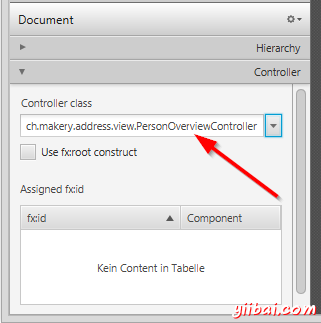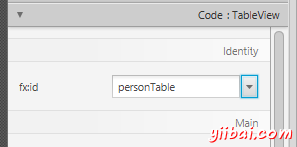JavaFX - Model和TableView
先來看看我們要實現的功能:

第二部分的主題
- 創建一個 模型 類。
- 在 ObservableList 使用模型類。
- 使用 Controllers 在 TableView 上顯示數據。
創建 模型 類。
我們需要一個模型類來保存聯係人信息到我們的通訊錄中。在模型包中 (ch.makery.address.model) 添加一個叫 Person的類。Person 類將會有一些變量,名字,地址和生日。將以下代碼添加到類。在代碼後,我將解釋一些 JavaFX 的細節。
Person.java
package ch.makery.address.model;
import java.time.LocalDate;
import javafx.beans.property.IntegerProperty;
import javafx.beans.property.ObjectProperty;
import javafx.beans.property.SimpleIntegerProperty;
import javafx.beans.property.SimpleObjectProperty;
import javafx.beans.property.SimpleStringProperty;
import javafx.beans.property.StringProperty;
/**
* Model class for a Person.
*
* @author Marco Jakob
*/
public class Person {
private final StringProperty firstName;
private final StringProperty lastName;
private final StringProperty street;
private final IntegerProperty postalCode;
private final StringProperty city;
private final ObjectProperty<LocalDate> birthday;
/**
* Default constructor.
*/
public Person() {
this(null, null);
}
/**
* Constructor with some initial data.
*
* @param firstName
* @param lastName
*/
public Person(String firstName, String lastName) {
this.firstName = new SimpleStringProperty(firstName);
this.lastName = new SimpleStringProperty(lastName);
// Some initial dummy data, just for convenient testing.
this.street = new SimpleStringProperty("some street");
this.postalCode = new SimpleIntegerProperty(1234);
this.city = new SimpleStringProperty("some city");
this.birthday = new SimpleObjectProperty<LocalDate>(LocalDate.of(1999, 2, 21));
}
public String getFirstName() {
return firstName.get();
}
public void setFirstName(String firstName) {
this.firstName.set(firstName);
}
public StringProperty firstNameProperty() {
return firstName;
}
public String getLastName() {
return lastName.get();
}
public void setLastName(String lastName) {
this.lastName.set(lastName);
}
public StringProperty lastNameProperty() {
return lastName;
}
public String getStreet() {
return street.get();
}
public void setStreet(String street) {
this.street.set(street);
}
public StringProperty streetProperty() {
return street;
}
public int getPostalCode() {
return postalCode.get();
}
public void setPostalCode(int postalCode) {
this.postalCode.set(postalCode);
}
public IntegerProperty postalCodeProperty() {
return postalCode;
}
public String getCity() {
return city.get();
}
public void setCity(String city) {
this.city.set(city);
}
public StringProperty cityProperty() {
return city;
}
public LocalDate getBirthday() {
return birthday.get();
}
public void setBirthday(LocalDate birthday) {
this.birthday.set(birthday);
}
public ObjectProperty<LocalDate> birthdayProperty() {
return birthday;
}
}
解釋
-
在JavaFX中,對一個模型類的所有屬性使用
Properties是很常見的. 一個Property允許我們, 打個比方, 當lastName或其他屬性被改變時自動收到通知, 這有助於我們保持視圖與數據的同步,閱讀 Using JavaFX Properties and Binding 學習更多關於Properties的內容。 -
LocalDate, 我們使用了birthday類型, 這是一個新的部分在 Date and Time API for JDK 8.
人員列表
我們的應用主要管理的數據是一群人的信息.讓我們在 MainApp 類裡麵創建一個 Person 對象的列表。稍後其他所有的控製器類將存取 MainApp 的核心列表。
ObservableList
我們處理JavaFX的view classes需要在人員列表發生任何改變時都被通知. 這是很重要的,不然視圖就會和數據不同步.為了達到這個目的,JavaFX引入了一些新的集合類.
在這些集合中, 我們需要的是ObservableList. 將以下代碼增加到MainApp類的開頭去創建一個新的ObservableList. 我們也會增加一個構造器去創建一些樣本數據和一個公共的getter方法:
MainApp.java
// ... AFTER THE OTHER VARIABLES ...
/**
* The data as an observable list of Persons.
*/
private ObservableList<Person> personData = FXCollections.observableArrayList();
/**
* Constructor
*/
public MainApp() {
// Add some sample data
personData.add(new Person("Hans", "Muster"));
personData.add(new Person("Ruth", "Mueller"));
personData.add(new Person("Heinz", "Kurz"));
personData.add(new Person("Cornelia", "Meier"));
personData.add(new Person("Werner", "Meyer"));
personData.add(new Person("Lydia", "Kunz"));
personData.add(new Person("Anna", "Best"));
personData.add(new Person("Stefan", "Meier"));
personData.add(new Person("Martin", "Mueller"));
}
/**
* Returns the data as an observable list of Persons.
* @return
*/
public ObservableList<Person> getPersonData() {
return personData;
}
// ... THE REST OF THE CLASS ...
The PersonOverviewController
現在我們終於要將數據加入到表格中了,我們需要一個控製器為了PersonOverview.fxml,.
-
在view包下創建一個名為
PersonOverviewController.java的普通java類(我們需要將這個類放在和PersonOverview.fxml相同的包下, 不然SceneBuilder會找不到它 - 至少在當前的版本). -
我們需要增加一些實例變量來訪問表格和在視圖中的標簽.這些屬性和一些方法有一個特殊的
@FXML注解. 這對於fxml文件訪問私有屬性和私有方法來說是必需的. 當將一切都在fxml文件中設置好之後, 應用程序會在fxml文件被載入時自動地填充這些變量. 讓我們添加以下的代碼:
PersonOverviewController.java
package ch.makery.address.view;
import javafx.fxml.FXML;
import javafx.scene.control.Label;
import javafx.scene.control.TableColumn;
import javafx.scene.control.TableView;
import ch.makery.address.MainApp;
import ch.makery.address.model.Person;
public class PersonOverviewController {
@FXML
private TableView<Person> personTable;
@FXML
private TableColumn<Person, String> firstNameColumn;
@FXML
private TableColumn<Person, String> lastNameColumn;
@FXML
private Label firstNameLabel;
@FXML
private Label lastNameLabel;
@FXML
private Label streetLabel;
@FXML
private Label postalCodeLabel;
@FXML
private Label cityLabel;
@FXML
private Label birthdayLabel;
// Reference to the main application.
private MainApp mainApp;
/**
* The constructor.
* The constructor is called before the initialize() method.
*/
public PersonOverviewController() {
}
/**
* Initializes the controller class. This method is automatically called
* after the fxml file has been loaded.
*/
@FXML
private void initialize() {
// Initialize the person table with the two columns.
firstNameColumn.setCellValueFactory(cellData -> cellData.getValue().firstNameProperty());
lastNameColumn.setCellValueFactory(cellData -> cellData.getValue().lastNameProperty());
}
/**
* Is called by the main application to give a reference back to itself.
*
* @param mainApp
*/
public void setMainApp(MainApp mainApp) {
this.mainApp = mainApp;
// Add observable list data to the table
personTable.setItems(mainApp.getPersonData());
}
}
可能需要解釋一下這段代碼:
-
所有fxml文件需要訪問的屬性和方法必須加上
@FXML注解.實際上,隻有在私有的情況下才需要, 但是讓它們保持私有並且用注解標記的方式更好! -
initialize()方法在fxml文件完成載入時被自動調用. 那時, 所有的FXML屬性都應已被初始化. -
我們在表格列上使用
setCellValueFactory(...)來確定為特定列使用Person對象的某個屬性. 箭頭->表示我們在使用Java 8的 Lambdas 特性. (另一個選擇是使用 PropertyValueFactory, 但它不是類型安全的).
連接 MainApp 和 PersonOverviewController
setMainApp(...) 必須被 MainApp 類調用. 這讓我們可以訪問MainApp對象並得到Persons的列表和其他東西. 用以下代碼替換showPersonOverview() 方法. 它包含了新增的兩行:
MainApp.java - new showPersonOverview() method
/**
* Shows the person overview inside the root layout.
*/
public void showPersonOverview() {
try {
// Load person overview.
FXMLLoader loader = new FXMLLoader();
loader.setLocation(MainApp.class.getResource("view/PersonOverview.fxml"));
AnchorPane personOverview = (AnchorPane) loader.load();
// Set person overview into the center of root layout.
rootLayout.setCenter(personOverview);
// Give the controller access to the main app.
PersonOverviewController controller = loader.getController();
controller.setMainApp(this);
} catch (IOException e) {
e.printStackTrace();
}
}
將View與Controller掛鉤
我們快要完成了! 但是有件小事被遺漏了: 至今冇有告訴 PersonOverview.fxml使用的是哪個控製器以及元素與控製器中的屬性的對應關係.
-
使用SceneBuilder 打開
PersonOverview.fxml. -
打開左邊的 Controller 組選擇
PersonOverviewController作為 controller class.

-
在 Hierarchy 組選擇
TableView並選擇 Code 組將personTable作為 fx:id.

-
對列做相同的事並且將
firstNameColumnandlastNameColumn分彆作為 fx:id . -
對在第二列的 each label , 選擇對應的 fx:id.

-
重要事項: 回到eclipse並且 refresh the entire AddressApp project (F5). 這是必要的因為有時候eclipse並不知道在Scene Builder中作出的改變.
啟動應用程序
當你現在啟動了你的應用,你應該看到了類似這篇博客開頭的截圖的程序界麵.


